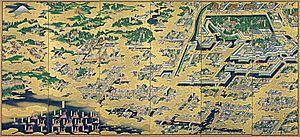Edo Castle facts for kids
Edo Castle is a famous castle built a long time ago, in 1457. It was built on flat ground by a person named Ōta Dōkan. Today, parts of it are used as the Tokyo Imperial Palace in Chiyoda, a special area in Tokyo. Later, a powerful leader named Tokugawa Ieyasu made it even bigger and stronger. Sadly, the castle was destroyed by fires many times throughout its history, but it was always rebuilt.
Contents
What Was Edo Castle?
Edo Castle was one of the most important castles in Japan. It was the home of the shogun, who was like a military ruler of Japan for many centuries. From this castle, the shoguns controlled the entire country during the Edo period (1603-1868).
Why Was It Important?
The castle was not just a home; it was the center of Japan's government and power. It was a huge complex with many buildings, walls, and moats (water-filled ditches) to protect it. Its size and strength showed how powerful the shogun was.
How Was It Built?
Building Edo Castle was a massive project. It involved many different lords and their workers from all over Japan. They brought huge stones and materials to construct its strong walls and towers. The castle was designed to be very difficult for enemies to attack.
Castle Parts
The castle had several main areas:
- Honmaru: This was the main circle or core of the castle. It contained the shogun's palace and the main tower, called the tenshu.
- Ninomaru: This was the second circle, located next to the Honmaru. It often had gardens, smaller palaces, and residences for important officials.
- Sannomaru: The third circle, which provided more space for offices and guardhouses.
- Outer Moats: Beyond these inner areas, there were many layers of moats and gates that protected the castle from the outside world.
The Main Tower
The tenshu, or main tower, was the tallest and most impressive part of Edo Castle. It was a symbol of the shogun's power. Although the original main tower was destroyed by fire and never rebuilt, its huge stone foundation can still be seen today.
Life at the Castle
Life inside Edo Castle was very busy. Thousands of people lived and worked there, including samurai warriors, government officials, and servants. Important meetings and ceremonies took place in the castle's grand halls.
Castle Defenses
The castle had many ways to defend itself:
- Strong Walls: Made of massive stones, these walls were very thick and tall.
- Deep Moats: The moats were filled with water and made it hard for attackers to reach the walls.
- Guardhouses: Many guardhouses, like the Hyakunin-bansho and Ō-bansho, were placed at key points to watch for any danger.
- Gates: There were many gates, such as the Ōte-mon and Hirakawa-mon, each designed to be a strong defensive point.
What Happened to Edo Castle?
After the shogun's rule ended in 1868, Edo Castle became the home of the Emperor of Japan. It was renamed the Tokyo Imperial Palace. Many of the original castle buildings were destroyed over time, especially due to fires and wars.
Edo Castle Today
Today, visitors can still see parts of the old Edo Castle. The beautiful East Garden, which was once part of the Honmaru and Ninomaru, is now open to the public. You can walk along the old moats, see some of the original gates, and imagine what the castle looked like centuries ago. The Imperial Palace itself is still used by the Emperor and is not fully open to the public, but its historical significance is immense.
Images for kids
-
Ukiyo-e print depicting the assault of Asano Naganori on Kira Yoshinaka in the Matsu no Ōrōka in 1701
See also
 In Spanish: Castillo Edo para niños
In Spanish: Castillo Edo para niños































